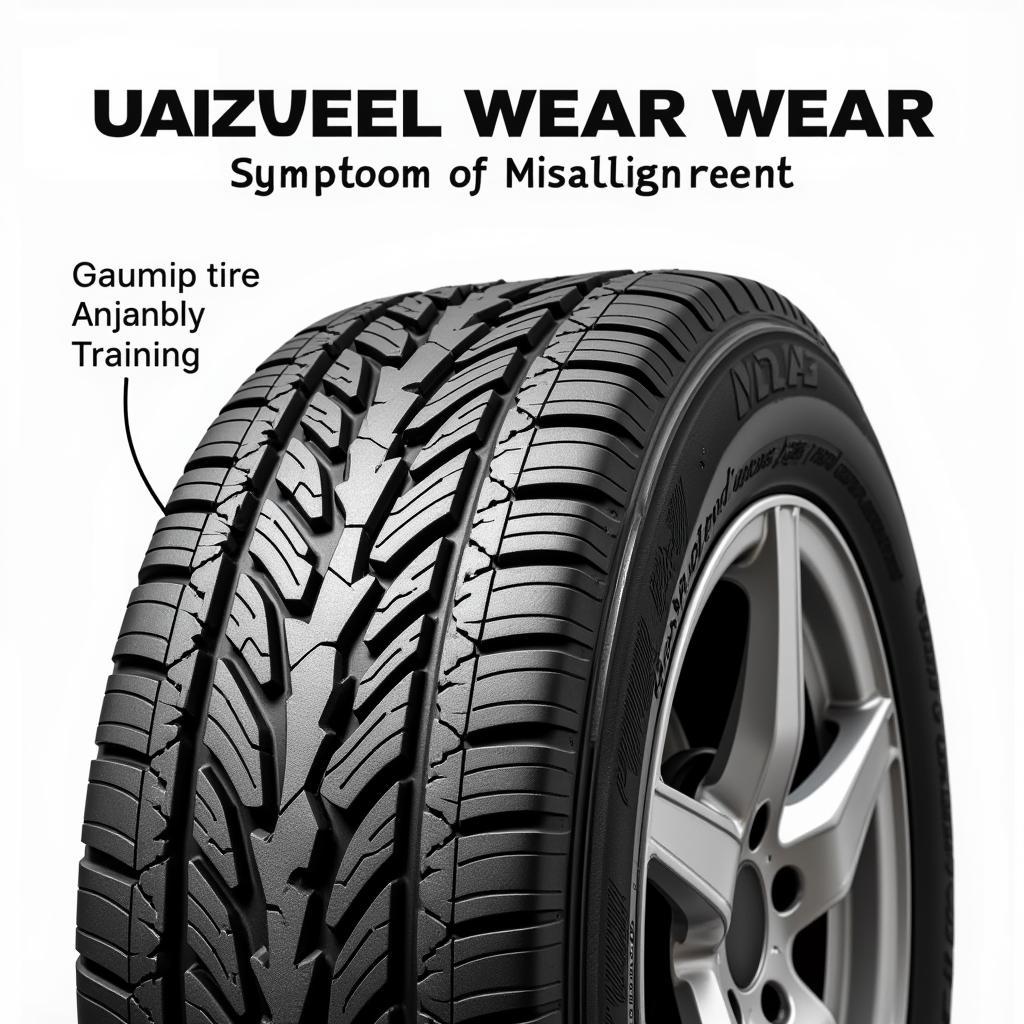Recognizing the Symptoms Of Alignment Problem Car is crucial for maintaining safety and extending the lifespan of your vehicle. Misalignment can lead to uneven tire wear, reduced fuel efficiency, and compromised handling. This comprehensive guide will equip you with the knowledge to identify and address these issues.
 Uneven Tire Wear Indicating Alignment Problems
Uneven Tire Wear Indicating Alignment Problems
Wheel alignment, often overlooked, plays a vital role in your car’s performance and longevity. It refers to the adjustment of the angles of the wheels so that they are perpendicular to the ground and parallel to each other. A properly aligned vehicle tracks straight, handles predictably, and maximizes tire life. Are you experiencing pulling, uneven tire wear, or a crooked steering wheel? These could be telltale symptoms of alignment problems.
Understanding the Root Causes of Misalignment
Several factors can contribute to wheel misalignment. Potholes, curbs, and even minor accidents can knock your wheels out of alignment. Normal wear and tear on suspension components like ball joints and tie rod ends can also cause gradual misalignment. Even something as simple as hitting a large pothole can throw your alignment off.
Common Symptoms of Alignment Problem Car
- Pulling to One Side: If your car consistently pulls to one side, even on a flat, straight road, it’s a strong indicator of misalignment.
- Uneven Tire Wear: Check your tires regularly. Excessive wear on one side of a tire or feathered edges are common symptoms of misalignment.
- Off-Center Steering Wheel: If your steering wheel is crooked when driving straight, your alignment is likely off.
- Squealing Tires: While squealing tires can be attributed to several factors, persistent squealing, especially during turns, could indicate an alignment issue.
- Vibration in the Steering Wheel: A vibrating steering wheel, particularly at higher speeds, can be a symptom of misalignment or other related suspension problems.
“Regular alignment checks can save you money in the long run by preventing premature tire wear and improving fuel economy,” says automotive expert, John Miller, ASE Certified Master Technician. He adds, “Don’t wait until you feel symptoms; it’s best to be proactive.”
Diagnosing and Addressing Alignment Problems
Identifying symptoms of alignment problem car is the first step. Next, you’ll need a professional alignment check. A technician will use specialized equipment to measure the angles of your wheels and adjust them to the manufacturer’s specifications.
What to Expect During an Alignment Service
- Inspection: The technician will inspect your suspension components for wear and damage.
- Measurement: Using an alignment machine, the technician will measure the current alignment angles.
- Adjustment: The technician will adjust the tie rods, control arms, or other components as needed to bring the alignment within specifications.
- Test Drive: After the adjustments, a test drive will confirm the effectiveness of the alignment.
For those looking to understand common breakdowns, check out the most common car breakdown problems.
“Ignoring alignment issues can lead to more serious and costly problems down the road, like premature suspension wear,” advises Sarah Johnson, Lead Mechanic at Johnson Automotive.
Preventing Future Alignment Problems
While some alignment issues are unavoidable, you can take steps to minimize the risk:
- Avoid Potholes and Curbs: Be mindful of road conditions and steer clear of potholes and curbs whenever possible.
- Regular Tire Pressure Checks: Maintain proper tire pressure to ensure even wear and reduce stress on suspension components. For more information on car problems, especially during winter, visit car problems in winter.
- Periodic Alignment Checks: Have your alignment checked at least once a year or every 10,000 miles, or as recommended by your vehicle manufacturer. If you’re curious about the rate of problems over time, check out rate problems distance over time car break diwn.
- Address Suspension Issues Promptly: If you notice any unusual noises or handling characteristics, have your suspension inspected and repaired as needed. Understanding the biggest problems with cars can be helpful. Also, for winter-specific issues, see winter weather car problems.
Conclusion
Understanding the symptoms of alignment problem car is key to maintaining your vehicle’s safety, performance, and longevity. By being proactive and addressing alignment issues promptly, you can save money on tires and repairs, and ensure a smooth and safe driving experience. Contact us at AutoTipPro for expert advice and assistance. Our phone number is +1 (641) 206-8880 and our office is located at 500 N St Mary’s St, San Antonio, TX 78205, United States.




Leave a Reply